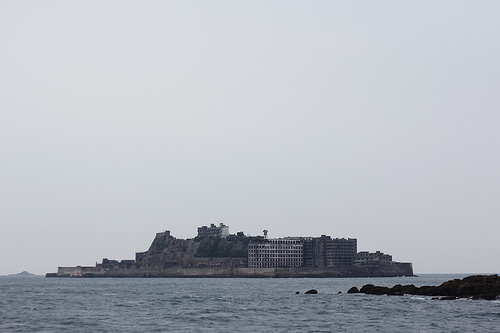Hashima Island is a mining ghost town… with a twist.
- Hashima Island is a small deserted, Japanese island that is found near the large southern island of Kyushu, in the Nagasaki Prefecture in Japan, Asia.
- Hashima Island covers an area of 0.063 square kilometres (0.024 square miles) or 6.3 hectares (15.6 acres), and measures approximately 480 metres (525 yards) in length and 150 meters (164 yards) wide; and the island is surrounded and protected by a high sea wall made of concrete, construction of which finished in 1907.
- ‘Hashima Island’ is also known as ‘Gunkanjima’, translated from Japanese as ‘Battleship Island’, referring to the similar appearance of the island to a battleship, in part due to its sea wall, and the island is also sometimes referred to as ‘Ghost Island’.
- In the early 1800s, coal was found on the uninhabited Hashima Island, and in 1887, a mine was constructed to extract the resource, however, it was only three years later, in 1890, that it was purchased by Mitsubishi, though mining continued until 1974.
- The UNESCO World Heritage Convention designated Hashima Island as part of the Sites of Japan’s Meiji Industrial Revolution: Iron and Steel, Shipbuilding and Coal Mining World Heritage Site in 2015, due to its infrastructure and industrial significance for Japan.
Hashima Island
Image courtesy of Japanexperterna/Flickr
- Once a developed underwater coal mine, Hashima Island was abandoned when the demand for coal waned in the late 1960s to the early 1970s, and the mine and island closed early 1974.
- The number of residents living on Hashima Island in 1959 was 5259 individuals, the greatest number in its history, and its population density broke records, with 1,391 people per hectare (563 per acre) in the residential area, or 835 people per hectare (338 per acre) taking into account the whole island.
- Hashima Island once contained buildings up to nine storeys high, and the community had a hospital, two schools, shops, a temple and shrine, restaurants and other facilities, most of which now sit in ruins.
- Between the 1930s and 1940s, Korean and Chinese folk that had been conscripted, or captured by the Japanese during World War II, were forced to work on Hashima Island due to labour shortages.
- Early in the 21st century, Hashima Island became more prominently known due to media attention, and this led to restoration of some areas for the safety of tourists, before it was opened to visitors in 2009; and in 2013, some of the streets and buildings were recorded in a 360° panorama by Google, allowing for virtual exploring.
Bibliography:
Burke-Gaffney, Hashima – Ghost Island, 2002, Cabinet Magazine, http://www.cabinetmagazine.org/issues/7/hashima.php
Gunkanjima, 2016, Japan Guide, http://www.japan-guide.com/e/e4414.html
Gunkajima Island, 2015, Atlas Obscura, http://www.atlasobscura.com/places/gubkanjima-island
Hashima Island, 2016, Wikipedia, https://en.wikipedia.org/wiki/Hashima_Island







